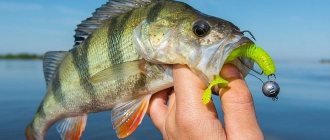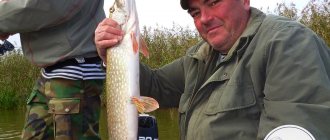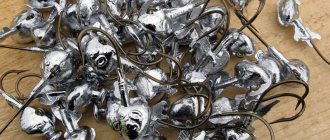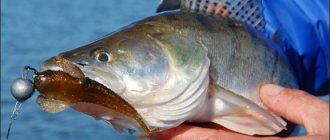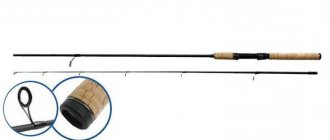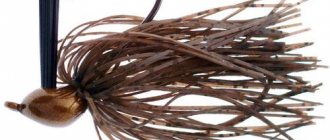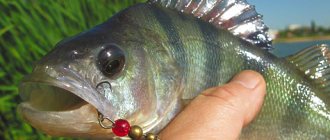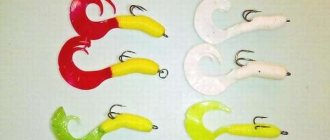Jig is a type of spinning fishing using jig baits. Their peculiarity is the spout surrounded by a lead sinker. Almost any of the various spinning rods can act as bait, but in 90% of cases fishermen deal with silicone and foam rubber:
- twister
- vibrotail
- foam fish
- worm
- crustacean
- squid
Jig fishing is characterized by stepwise fishing. You throw the bait into the fishing spot, wait for it to fall to the bottom, and the line will sag at that moment. Make 0.5-3 turns and again wait for it to fall to the bottom. This is what step wiring is all about. It allows you to fish the bottom, and the jig is perfect for this.
Another important element of such equipment is the jig head . This is a lead weight on the hook on which the bait is attached. But not all rigs have a jig head. Some are attached with a regular Cheburashka sinker, as in the photo above.
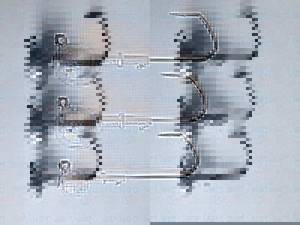
Nowadays the jig fishing method has become increasingly popular. It attracts with the opportunity to catch a truly trophy specimen, regardless of the time of year, fishing conditions and with the most budget bait.
Unlike other baits, in particular wobblers, the cost of a jig is several times cheaper. In addition, you can make it yourself, which is very profitable.
Jig belongs to the category of the most effective methods of bottom fishing using spinning. Jig is the name of an English dance, therefore, jig means to dance, to dance with a lure.
Spinning for jig
When choosing a spinning tool for jig fishing, it is recommended to consider the following parameters:
- Possibility of casting twisters, vibrating tails with a jig head, the weight of which is from 10 to 40 grams. over long distances.
- The sensitivity of the gear to the behavior of the bait in the water (touching the bait to the bottom surface), to the careful bites of a predator.
- The ability of the tackle to produce confident hooks.
- Withstand the weight of weighted jig heads (heavy models of jig tools).
It is a well-chosen spinning rod that can ensure the success of jig fishing. Depending on the conditions of the future hunt (from a boat, from the shore, in what depth of the body of water the hunt will be carried out), the nature of the gear is determined.
Characteristics
The main performance qualities of the fishing rod include:
Rod test

This indicator reflects the permissible weight of the bait, which does not impair the normal operation of the spinning rod: the ability to make high-quality casts over long distances, feel the retrieve, etc.
The optimal indicator for jig is 10-40 g. If fishing is carried out from a boat, then casting is not always advisable. Therefore, the stick will be suitable with a smaller test load. But long-distance casting of heavy jig heads and fishing at great depths should be carried out with a high-test spinning rod.
Length
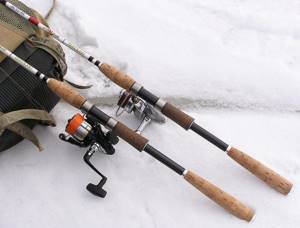
The ideal length of the tool for the jig fishing method should be 240-270 cm. A shorter rod may cause difficulties with casting range, given the light weight of the bait.
You should also not choose a stick that is too long, although if a professional fisherman is working, then a spinning rod with a length of 330 cm is quite suitable for him. For the amateur level, 240 cm is quite enough.
Build
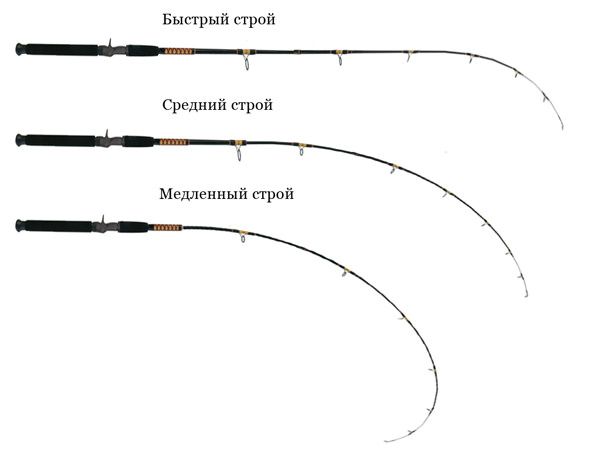
Here you can use a spinning rod with both fast and slow action, which is equally effective. Choosing the right tuning is much more difficult than deciding on the length. This parameter cannot be determined by eye, it needs to be felt.
The structure of the spinning rod allows you to understand how flexible the tackle is and how quickly it reacts to a bite. Even with fast tuning, one can observe increased sensitivity to the slightest influence, and this is provided that only the tip of the instrument is bent.
It is also called end formation. There is a parabolic version of the action, slow, where the entire length of the rod bends.
When choosing a system, you need to focus on the priority of the tasks:
- If long and soft casting is important, then you should take a slow one.
- If the information component and the sensitivity of the tackle to jig wiring are important, then a fast action is suitable.
A good solution for jig fishing is the use of a combined action, where under light loads the performance characteristics of a fast action appear, and in case of serious impact - a parabolic action.
Telescopic rods are the worst at signaling bites. Most often, it can only be detected visually. The tip of the spinning rod, due to numerous connections in the links of the tool, cannot transmit a bite signal to the angler’s hand.
Material
Here it is important to decide on the length of a particular fishing rod, and based on these parameters, choose the material:
- If we consider a 3-meter rod made of simple fiberglass, which has significant weight, then certain difficulties will arise during its operation.
- If we are talking about long fishing tools, then you need to give preference to carbon fiber or composite materials.
Which to choose?
To finally make a decision on purchasing a specific spinning rod model, it is recommended to pay attention to:
- For compliance of the model with the expected hunting conditions, the type of fish that will be hunted, the weight and shape of artificial baits, and casting range.
- Compliance with price and quality: an excellent tool and well worth it. If we consider a budget option for gear, then the price should not be lower than $100 (Daiwa Tornado - Z, Shimano Catana CX, Bass Pro Shops, Volzhanka are considered worthy models). It is better to purchase such tools in specialized stores, where there is a guarantee and a certificate of product quality.
Models
If you think that fishing with jigs on spoons is an expensive pleasure, then this is not so. In some situations, of course, there is a need to use expensive specialized branded models, but in general it is quite possible to get by with handmade lures, which should have only the main thing - the necessary game on the fall, everything else - the precision of the form and the class of surface cleanliness - is secondary. You can make dozens of the same approximate analogues of castmasters and throw them wherever your heart desires.
Cheap baits also include spinners of our production, which were produced and are currently being produced. Some models from the eighties are absolutely in no way inferior to the coolest American, Canadian, Swedish, Norwegian and Finnish lures. Only in beauty.
Often there is a need to use casting when particularly heavy, rather large baits are needed, for example, made from printing alloys. Here, too, the fisherman will have to work with his hands.
So this fishing is quite affordable and popular and should, in theory, become more widespread.
If we take standard store options, then below I will give my choice.
There will be no new-fangled lures here. No special searches are needed - “everything is around the corner.” All familiar names. With an impeccable reputation. Many have been produced for decades, and some have passed half a century.
Acme Kastmaster.
Where would we be without him? A spinner for fishing in still water and in “difficult” currents. For reservoirs of any size. How many times have you helped out when nothing could help?
A wide variety of sizes and colors allows you to use this spoon for any fish and at any distance. The only problem for him is a decent depth with the current, when you need more ax-shaped baits that sink to the bottom faster. Its use in connection with asp has long become common place. Nothing to add here.
Small castmasters are often the only option for catching distant perch that don’t like the speed at which a jig with a medium-sized silicone falls, which in principle can be thrown at it. I consider medium-sized ones (10.5–21 g) to be an excellent jigging pike spoon for moderate depths with gentle currents. When fishing with castmaster, you can experiment a little - swap the nose and tail. This will change the game on the fall and may affect the number of bites.
Analogues and fakes of Kastmaster.
To be honest, I haven't come across any clones that were outright bad. Maybe I was not looking for cheapness, so my fakes are not magnetic and do not rust. And everyone catches great. When it comes to the danger of snagging, their use becomes one hundred percent justified. After all, tearing off a spinner very similar to the original, but three to four times cheaper, is much more pleasant in every sense. Analogues in design, naturally with good working qualities, but with different proportions, catch, in relation to jigs, in approximately the same way. In some cases it is better, in others it is worse.
Halco Twisty and Hexagon.
“Twistik” can just replace the castmaster in those difficult river conditions when it cannot cope, due to the higher falling speed due to the game being close to falling. Hexagon is more versatile; with a fairly standard feed, it is also quite suitable for standing water.
"Three-sided"
. Great Russian spinner. The same all-season as the castmaster. It also catches everything, depending on the size. Unfortunately, its serious production at real prices has not been established, so we have to take care of each one. With weight parameters comparable to the castmaster, it penetrates much deeper (narrow profile and crumbling game).
A small three-sided fish, which until now was only a winter bait, once amazed me with its working qualities in a jig. About seven years ago, while going to pick up an asp, I found myself in the passage of a cold front. The fish, which just yesterday had been rowdy at the top, suddenly sank to the bottom into deep furrows with a decent current. I thought that I wouldn’t catch anything at all, because the temperature had dropped by more than ten degrees. This is exactly what happened among the people. It was impossible to reach the bottom with a small castmaster. I set up this trihedral and began to fish the nearby bottom ditch. And in two hours, with a neat bottom jig, I took six medium-sized asps, with complete zeros from the rest. There was something to brag about. The fish caught almost five centimeters from the bottom.
Kuusamo Rasanen.
A spinner that works well both on a uniform retrieve and on a stepped retrieve. Moreover, all types are popular for jigs. It’s not for nothing that small Rasanen are considered full-fledged baits for vertical trolling, in addition to their main summer purpose. In our conditions, an incomparable pike lure. In shallow water - model 70/10. For sparse grass and snags - 70/10 with a rigidly attached or 70/20 with a freely suspended protected double. At medium depth - 70/20. For active or large fish, as well as for good pike perch - 90/28. Both perch and burbot fly in (on the “seven”).
Bete Krokodil.
A classic that has given rise to a bunch of imitations, including in our Soviet fishing industry. It is also equally good on straight winding and on a step. The most universal size is 70 mm. Pike, perch, pike perch, and sometimes even ide take advantage of it. A small one - “six” - will increase the number of perch in the catch, and even the white predator. A large one - 80 mm long - will increase the number of bites from respectable pike. In this model, it is worth thinking about the right choice of color (and they have a lot of solutions!) - often this makes a noticeable difference.
Abu Garcia Toby.
Another recognized world masterpiece. Although it is a classic river salmon lure, it also perfectly catches pike in any waters (which, by the way, has been repeatedly mentioned by foreign pike authors). I myself caught toothy ones with it in lakes and forest rivers, and of course with a jig in suitable places. The model weighing 28 g seems most interesting to me, especially the silver color, with red fins, and the warmest memories are associated with it.
During the fall, this version of Toby, naturally, if we are not fishing in shallow water zones, makes small sharp fluctuations, approximately in the same vein as with direct retrieve. Fish sometimes really like this.
Gibbs Ruby Set.
Very light spinner. It flies poorly, but at short distances and shallow depths, jigging along a wall of reeds or in windows can be extremely useful. When there is a pause in the retrieval, it is better to release the fishing line with the tip of the rod (so as not to interfere with the bait by the tension of the cord), it, one might say, “crumbles” in an absolutely horizontal position and sometimes goes slanted to the side. Pike loves this, and perch sometimes jumps out of the grass after it.
Lure Jensen Hobo.
It may seem strange to some that a bait of this type is included in this list, but this is by no means accidental. Such non-snacking glider-type skids are very interesting to play when falling. They fall with a hook on top, alternately performing small glides to the sides, while the carmine-colored feather tail wags seductively - the pike cannot resist.
A huge advantage of this spoon is that, being unprotected by any whiskers, it very poorly collects all sorts of rubbish from the bottom, since it tries to lie on it straight up with the hook. This makes it possible to fish both on a peaty bottom and on a bottom covered with small vegetation, which is typical for depths of about 3–4 m in many lakes or quarries with white transparent water (for example, in Valdai).
Rapala Minnow Spoon.
It's corny, but there's no getting around it. Good in any performance. And small, and large, and non-clinging, and with a tee. The game on the fall can be called wobbling and gliding. It is quite applicable not only in any conditions of standing water, but also on the river, especially if fishing is done from the shore, and the coastal zone is shallow and with the presence of a certain amount of rare grass. It is highly desirable to equip the hook with a twister tail (except for the model with a fly on a tee) - it increases the pause time when stopping the retrieve and further increases its attractiveness to fish. While this may not be so important for pike, for perch this option increases the Minnow Spoon’s catchability significantly.
Acme Little Cleo.
Whatever size you take, it will find its application in jigs. Inimitable game on the fall. The most, in my opinion, the most beautiful and bewitching of all the vibrations. Small ones, naturally, for perch and white predator. The middle ones are more or less universal. Well, large ones are an excellent pike lure for small and medium depths.
DAM Effzet.
The German vision of a universal oscillating spoon. Suitable for jigging in all sizes. And if the large option is really a pike killer, then when the size decreases, it begins to catch pike perch, and the smallest size works great for good perch, sometimes and, by the way, often outperforming the castmaster.
In addition to the above, we can also mention such spinners as the long-discontinued Blue Fox Jurmo, especially weighing 23 g (pike), Puustjarven Kalastaja (pike), Luhr Jensen Krokodile (pike-perch), Eppinger Dardevle (Midget and Spinnie - for perch and white predator , large options - for pike), Thomas Canduit (perch), Abu Garsia Atom (small - perch, large - pike). And a whole set of our domestic spinners: “Excellent” (analogous to Bete, catching both pike perch and perch, and of course pike, and even ide), “Udachnaya” (with the same track record, only an order of magnitude more deserved for perch and often attractive asp), “Lena” (a good river spoon, except for perch and pike, it is excellent at catching ide and chub), “Scaly Spoon” (any small predator, up to three-hundred-gram perch), “Ladoga” (similar).
This is all what my friends and I have successfully fished using jigs. In fact, the choice is much wider, it’s just not possible to test everything properly - there’s not enough time, because our summer season is not that long.
Jig reel
There are two types of coils:
Inertia-free
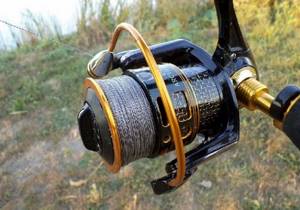
Characterized by simple design and ease of operation. There is a fairly extensive range of such products on the market, and choosing the right option will not be much of an effort.
The main thing is that the product meets the following requirements:
- Instant reverse stop.
- Equipped with an enlarged spool.
- The spool and roller are made of high quality material.
Inertial
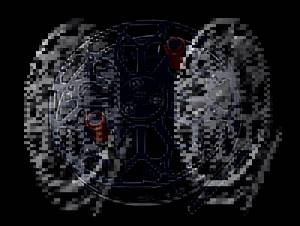
Modern models of multiplier inertial reels are practically not inferior in their performance to inertia-free products. They attract consumers with the high speed of winding the fishing thread, and allow them to feel the signal notification of a bite through their fingers (from the fishing line).
How to choose a jig head?
A jig head is a type of ordinary sinker, but it is the correctly selected weight for the tackle that will be the key to successful fishing.
Important factors to consider when choosing a jig head:
- quality;
- form;
- weight;
- method of fastening.
It is worth talking about these features in more detail.
Form
The forms in which jig heads are presented are produced in a wide range.
The most popular sinkers are made in shapes associated with:
- ball;
- a rugby ball;
- digger;
- skiing;
- fish head;
- bullet;
- boot or iron;
- spoon;
- horseshoe;
- tumbler (tumbler);
- banana.
Any of the presented forms of jig sinkers is selected in accordance with the need and a certain type of reservoir (still water or a reservoir with a current).
Weight
A mandatory factor influencing the choice of a jig head is weight. Correctly determining the horizon of the rig's passage can only be done by choosing the optimal weight parameters of the sinker along with the bait.
Fishing in still water and shallow depths requires choosing a sinker weighing no more than fifteen grams. River fishing or depths greater than five meters is determined by the choice of a sinker weighing up to forty grams.
Mounting method
According to their type, jig heads are divided into two categories:
- cast with hook;
- cast without a hook.
The first category of heads has gained the greatest popularity among fishermen.
The head cast with a hook has the appearance of a large and heavy jig with the integral presence of a ring and a retainer.
The location of the ring must necessarily correspond to a right angle in relation to the forend. The purpose of the latch, in this case, is to prevent rather soft-bodied baits from spinning and coming off.
The clamps are manufactured in the form:
- ball;
- arrows;
- umbrella or fungus;
- needle or thorn.
The second category of sinkers is connected to the hook by certain hinges, and the jig heads themselves are cast in the form:
- sinkers with ears (the fishermen gave it a more accurate description - Cheburashka);
- lentils.
It would not be amiss to mention the suspension point. This is exactly the place where the ring will be located, to which the fishing line will be attached.
There are three groups of suspension points:
- Frontal. This group of suspensions is capable of holding the jig head in an almost vertical position. This hanger is suitable for a banana-shaped sinker.
- Standard. This group of hangers is capable of holding a sinker with a certain slope. This suspension is suitable for a sinker in the shape of a ball (when fishing in still water) or in the shape of a fish head (when fishing in moving water).
- Central. This group of suspensions is capable of holding the jig head in an almost horizontal position. This suspension is suitable for a boot-shaped or iron-shaped sinker.
Workmanship
Sinkers made of tungsten alloy are of the highest quality. They are more compact and have increased strength, which is important when the sinker hits rocks. The only drawback of tungsten jigs is their high price category.
Heads made of lead are much cheaper than tungsten ones, and therefore they are most often purchased in stores. A significant disadvantage of lead weights is the possibility of oxidation over time.
Let's celebrate! Brass sinkers are also used in jig fishing, but have not received positive reviews among anglers due to their impracticality. The metal is quite soft and deforms quickly.
fishing line
You can jig with either monofilament line or braided line. But most spinning anglers are inclined to choose high-quality braid: it has minimal stretch and adequately informs about the behavior of the bait in the water.
The cord allows for short and powerful strikes, piercing right through the predator’s hard mouth.
Unlike monofilament, the percentage of trophy specimens recovered is several times lower.
As for the diameter of the braided thread, it all depends on the type of intended fishing object:
- If this is a perch in the current (with a transition from shallows to depth), then a thickness of 0.10 - 0.12 mm is suitable.
- If this is a pike perch in the current , then the thickness of the braid should be 0.12 - 0.17 mm. The thickness of 0.19 mm will be relevant for hunting in snarled areas of the reservoir. Taking into account the advantageous position of the bait in such conditions (hovering when stopping above the bottom surface), the predator is motivated to attack the prey offered to it.
- If it is a pike , then the optimal solution would be to use a cord with a diameter of 0.12 - 0.17 mm. For trophy pike (25-30 kg) you will need a braided fishing line with a thickness of 0.20 - 0.40 mm.
How to choose a working jig spinner?
You can determine the working qualities of a spinner and find out whether it is really a jig spinner using a fairly simple test. To do this, take the bait being tested on a fishing line and lower it vertically into the water. The experiment site must have a depth of at least 50 cm.
Next, the turntable should begin to be moved in a vertical plane from the surface to the bottom and back. In this case, it is necessary to pay attention to how the bait behaves. If the petal of the spinner being tested sticks, rotates incorrectly, does not start right away, and the hook constantly gets caught in the fishing line, you can safely put the bait aside, since it is not a jig. This kind of bait can be successfully fished using a wide wavy or uniform retrieve, but not a stepped retrieve.
If, in such difficult conditions, the tested spinner works stably and reliably, does not stick, rotates easily both in a vertical rise and in free fall, and does not overwhelm at all, this means that you have a real working jig spinner in your hands.
Jig baits

Twisters and a sinker weighing 4 grams. They are connected into a ready-made jig rig using an offset hook. The eye can be easily pulled out of the sinker, so you can assemble the equipment without a winding ring.
The use of jig baits makes it possible to hunt any predator, regardless of the type of reservoir, depth, in the current or in its absence. They can fish even the most difficult places: snagged, rocky and overgrown with vegetation.
The main thing is to follow the rules for equipping such baits for each specific case.
Depending on the game, jig baits are classified into:
- Active (vibrating tails, twisters), which are in particular demand among Russian spinning fishermen.
- Passive (all possible variations of exotic living creatures in the form of lizards, crustaceans, mollusks, etc.), with which you can also catch white fish.
To make fishing effective, you should choose the right size, color and material of the jig bait.
To provoke a large predator to bite, you should select a large bait and vice versa. So, a bait with a size of 10-13 cm is suitable for pike, a bait of 7-9 cm should be used for pike perch, and 3-6 cm for perch.
If the bait is made of soft material, then the game will be quite active and lively. But given the structure of such a product, it will not last long (it will not withstand bites from the teeth of a predator).
If it is a bait made of hard material, then the product will not lose its qualities, despite the injuries received during the fishing process, but it will be difficult to attract the object of the hunt.
They produce jig baits in a wide range of colors: from brightly aggressive to naturally calm.
In sunny weather, it is recommended to use natural colors, and in cloudy weather, brightly saturated shades.
The most popular type of jig baits are vibrating tails , which imitate live fish. They can be in both narrow and wide forms.
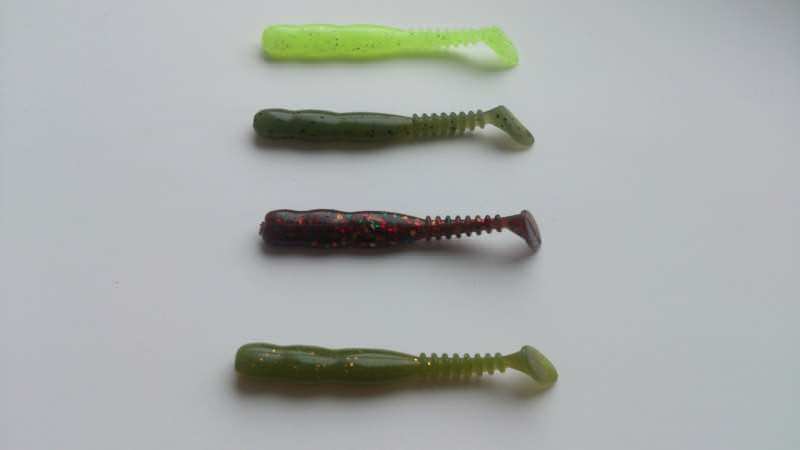
Vibrating tails for jig fishing, made by hand by pouring silicone into molds
New installation of jig bait
The installation of a jig bait on a ball weight with two eyes can be called classic - it has stood the test of time. The practicality of such installation is undeniable, but still it is not free from shortcomings. Sometimes a situation arises when a predator, especially a pike perch, closes its teeth on or in front of the weight. When hooking, the bait does not move and the hook is not set. This happens especially often if the diameter of the load exceeds the width of the hook. The second drawback is that during flight, the cargo and the bait are flown by air separately, as a result of which their aerodynamic resistance adds up.
The proposed installation is free from these disadvantages. Its peculiarity lies in the fact that it uses a weight not with two, but with one eye, to which both the bait and the leash are attached. The latter is made from guitar string. Winding rings are not used. What are the advantages of such installation?
In the predator's mouth, the bait is compressed in such a way that the hook tips almost always touch the jaws or palate. If the load becomes pinched during the usual “lead-weight-bait” installation, for effective hooking the weight must be pulled between the closed jaws (Fig. 1), which requires significant force. In the “leash-weight + bait” installation, the hooking force is first spent on turning the weight in the fish’s mouth (Fig. 2). The force required for this is significantly less than that required to pull it between closed jaws. When turning, the weight acts as a lever, facilitating the penetration of the hooks. Moreover, the size of the load - its diameter - in this situation does not interfere, but, on the contrary, contributes to hooking. The second advantage of this installation is a significant reduction in aerodynamic drag.
The effect is especially strong when using foam fish. The bait moves in the “wake” of the sinker, smoothing out the eddies. The front part of the leash should be curved along the profile of the bait, as shown in the photo. In flight, the bait and cargo are located on the same line, and a “corkscrew” occurs extremely rarely. A decrease in aerodynamic drag leads to a sharp increase in casting distance. When using thin lines, the range increase can be up to 20-30%. Another feature of the “one-ear” installation is that, thanks to less resistance, it reaches the bottom faster and knocks on it more clearly. This property can be used for fishing areas of a reservoir with great depths and strong currents, if an increase in the weight of the cargo is undesirable for some reason. For example, when you cannot overload the spinning rod or there is a danger that the line will break when casting. In the described installation, only one drawback has been noticed so far. If the hook points stick out from the bait, then when casting they sometimes cling to the leash. For me personally, this is not significant, since I almost always use foam rubber with pressed tips, and I mount the twisters on an offset hook. Such baits are much less likely to cling to snags, and I did not notice an increase in the number of slips.
Author Vasily Pilipchuk
Fishing process
Most often, our fishermen use the classic step in the jig fishing method.
For this:
- Casting is in progress. You need to wait until the bait can calmly sink to the bottom (the line will sag).
- Take the spinning rod at an angle of 45 degrees relative to the water surface and perform rotational actions with the reel handle (3-4 turns are enough). Again you need to wait until the bait comes into contact with the bottom surface (the thread will sag and the tip of the tool will straighten) and repeat the reeling again.
- You need to rotate the reel very quickly, as well as stop it - smoothly. After which you need to wait until the bait touches the bottom and repeat the entire cycle of actions until a bite is detected.
- The hook must be immediate , otherwise the predator may spit it out, suspecting deception. You should not expect an aggressive attack on the bait, as happens with a spinner or wobbler.
- It is recommended to fish using a friction brake (to dampen the jerks of the predator).
Choosing the type of jig spinner hook and its equipment
A rather important point that directly affects the catchability of the bait is the choice of the type of hook and the method of equipping it. The jig spinner can be equipped with a double, triple and single hook, depending on the fishing conditions. The most reliable and effective is to use a treble hook, but this is fraught with numerous hooks and, as a result, the loss of a relatively expensive bait.
Double and single hooks on “dangerous” directions are much more effective, especially if they are oriented with their tips up, but at the same time the reliability of the hook is somewhat deteriorated. By the way, unlike tees, doubles and singles can be equipped with various types of anti-toe systems in literally a matter of seconds.
The simplest of these systems are wire or fishing line hook protection. You can also use an offset hook for these purposes, the tip of which is hidden in the body of the twister. In addition, the twister gives the jig spinner some smooth play on stepped retrieve and additionally attracts a predator. Anti-hook jigs can be very effective in fishing the most inaccessible places for other baits, where there are usually a lot of blind hooks.
Adviсe
- It is more advisable to use a braided cord rather than a regular monofilament line.
- To interest a predator, you need to use a rig with a retractable leash.
- An offset hook will come in handy here: it’s sharp and prevents the bait from clinging to underwater obstacles.
- The most effective is stepped wiring.
- Don't neglect the colors of the bait, you need to experiment.
- To increase the frequency of the game, you can additionally twitch the rod.
- You need to choose only high-quality gear.
The device of a jig spinner using the example of spinners of the “Master” series
One of the most worthy representatives of jig spinners can rightfully be called the “Master” spinner. The design of the spinners in this series was developed based on many years of experience and incorporates the best qualities of jig spinners. Let's consider the turntable of the “Master” series element by element from the point of view of efficiency and expediency.
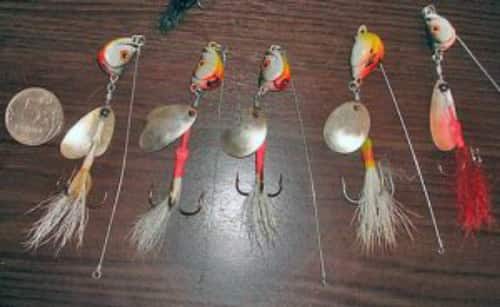
Weight head of jig spinner
Color and painting improve the appearance of the spoon, but it is more effective on the angler than on the fish. However, if you take a closer look at the shape of the head and the location of the loops for fastening, you will find that it is made very competently.
The teardrop-shaped head of a jig spinner provides a number of advantages compared, for example, with a conventional “eared” sinker.
Firstly, such a load during wiring creates a minimum of turbulence, which can worsen the operation of the petal, while at this minimum size it has close to the maximum weight and excellent aerodynamics.
Secondly, at the moment of casting, such a streamlined sinker flies with its thickened part forward, and the axis of the spoon with the petal plays the role of a stabilizer, rather than a sail, as a result of which the casting range is significantly increased.
Thirdly, at the time of performing a stepwise retrieve, the spinner, due to the wide bevel in the lower front part of the sinker, despite its significant weight, quite easily “takes off” from the bottom, which significantly improves the quality of the retrieve. By the way, a “eared” sinker of similar weight in the same situation will raise the bait much lower.
Fourthly, after touching the bottom, the “master’s” sinker, due to its wide base, does not fall on its side. Fifthly, the loops at the weight-head are located significantly above the center of gravity, which completely eliminates the rocking movements inherent in the “eared” sinker, which during wiring do not allow the petal to rotate stably. These same advantages of a “master” sinker over a regular “eared” sinker can be taken into account when weighing down other jig baits such as “foam” fish, twisters, vibrotails, etc.
Now let's look at the spinner itself
The spinner axis is made with a pin fastening tee made of steel wire. The pin itself serves as a support for the bead-bearing, on which the collar with the petal rests. One of the features of the “Master” spinner is the use of a thermophytic retaining tube.
The thermophyte tube prevents spontaneous unfastening of the pin at the time of playing a fish or simply under load, for example at the moment of hooking, and fixes the hairs on the tee, which are necessary and desirable in the design of a jig spoon of this type to stabilize its play during retrieving and increase the smoothness of movements.
In addition, the thermophyte tube rigidly fixes the axis of the jig spinner and the tee on the same line, which completely eliminates the tee from tangling with a steel leash or fishing line at the time of casting and, which is very important, does not allow the tee to interfere with the free rotation of the petal during the fall.
The Master jig spinner is equipped with two winding rings that allow you to quickly change various elements of the spoon depending on fishing conditions and at the same time provide additional degrees of freedom that allow the bait to be compactly positioned at the time of casting. A sufficiently long and elastic leash made of steel wire, which is also provided in the design of the “master’s” spinner, will not allow the pike to escape with impunity.
Rules for jig fishing or jig fishing
Well, we’ve come to the “golden” rules that it is advisable to follow if you decide to fish with a jig. All these rules are probably not mandatory, but I know them, and I adhere to them, and whether you follow them is your decision, but you need to know.
A little history
For several years now I have been successfully catching predators (pike, pike perch, perch) using jigs. It would seem that so much has already been said about this tackle that it is almost impossible to tell anything new. But, as practice shows, beginners and experienced fishermen who want to master jig fishing quite often make the same mistakes, which results in a complete lack of bite and a spoiled mood. Jig fishing, like everything in life, has its own rules and secrets, knowing which you can save a lot of time and spend quite productive time on the pond.
I will try to briefly outline the basic rules of jig fishing, which help me in most cases to stay with the catch. I will not describe each point in too much detail in order to give free rein to your imagination and put into practice what you read. It seems to me that this approach is the most optimal, since some understatement encourages action. So, let's begin …
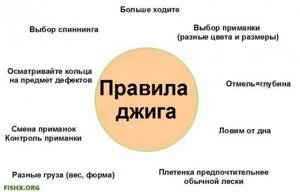
Jig fishing rules:
- The right spinning rod is the key to success. You can talk about testing the spinning rod, its structure, etc. The main requirement is this: if you fish with light baits, the tip of the spinning rod should bend moderately under their weight and play back. This is necessary in order to be able to determine the bottom, bite and other parameters using the tip of the spinning rod. If, for example, you put a 10 gram jig head on a spinning rod designed for baits up to 90 grams, it will be impossible to catch quality fish. Therefore, the spinning rod must match the bait used. As a last resort, you can use a spinning nod, which is to some extent capable of reacting to the movement of the bait on the bottom and displaying everything that happens to the bait. The spinning rod should be no longer than 2.7 meters. Many people fish with longer spinning rods, but I personally didn’t like it, since the casting range increased slightly, but observing the bait somehow became more difficult.
- Choice of bait. Silicone baits (vibrating tails, twisters, frogs, worms, etc.) and foam fish are more suitable for jig fishing. But sometimes, fishing with ordinary baits (spinners, for example), which I use using the jig method, gives excellent results.
- You can fish with a jig from deep to shallow water and vice versa. For some reason, many fishermen adhere to one of the options.
- You always need to let the bait sink to the bottom first, and only then implement one or another method of play.
- Braided fishing line is preferable to fishing line, since at great depths and currents it is braided line (due to the fact that it does not stretch) that allows you to almost directly feel the bait and determine the bottom topography. The fishing line, due to its elasticity, significantly complicates these processes and prevents adequate hooking.
- It is advisable to have jig baits of different sizes available.
- Jig weights should be available in different weight distributions and different shapes
- If one method of playing with bait does not give results, you need to try another. And only after using several wiring and playing options, change the place.
- Change baits often. I have observed how some fishermen fish almost their entire fishing trip with one bait. If there are no bites on the bait within 30-60 minutes, try changing it. Change baits more often - it works.
- Control the bait. Important rule. Even when you need to create a slight slack in the line, the bait must be under control. This is achieved by moderate line tension and a sense of acceptable sagging, when you know that by slightly lifting the rod, the tension will be restored.
- The bottom is the main place for jig fishing.
- If you find yourself in difficult places, fish them using unhooked jigs. Sometimes, it is better to lose 2-3 baits, but at the same time pull out a trophy.
- The success of jig fishing directly depends on the distance traveled on the reservoir. You have fished the area, move on. Jig fishing is active fishing.
- After each fishing, inspect the rings on the spinning rod and the line guide. Braid has such an unpleasant property as cutting rings. It’s unpleasant when the ring of a spinning rod is rubbed at the most crucial moment and at the same time tears the braid.
Just 14 simple “golden” rules for successful jig fishing. But in order to experience all this from my own experience, I had to spend more than 2 years. And the spinning rods broke, the rings tore the braid, bites were missed, etc. Don’t repeat the mistakes of others, have fun fishing. Let's move on to the improvements.
Jig fishing methods
There are many ways of jig fishing. But the article will tell you about the most popular wiring:
- Stepped (classical).
After casting, the bait sinks to the surface of the bottom of the reservoir, and the fisherman makes up to three rotations of the reel. A short pause, during which the bait rises, moves two meters and returns to the bottom surface.
And again the fisherman comes into play, winding the fishing line. By watching the tip of the blank, you can determine when the bait will land on the bottom surface. The blank is completely straightened, and the step bends the top (quivertip).
- American.
This wiring is more popular when hunting pike perch. The bait falls to the surface of the bottom, and the fisherman pulls it with a jerk along the bottom, to a length of up to two meters, but not with a reel, but with the blank itself.
- To be demolished.
After the bait falls to the surface of the bottom, the fisherman begins the game: slightly lifting the bait, moving it through the water column and falling to the bottom. These actions can be carried out for a long time.
- Aggressive.
This type of wiring will appeal to hunters of pike, perch or pike perch. The bait fell to the surface of the bottom, after which the fisherman makes a sharp jerk upward, which causes it to rise and fall down again. Next comes the time for a new breakthrough.
- Uniform.
When casting, the bait does not reach the bottom surface, but hangs in the middle. At this moment, the fisherman, slowly rotating the reel, makes it move strictly horizontally (parallel to the bottom surface).
